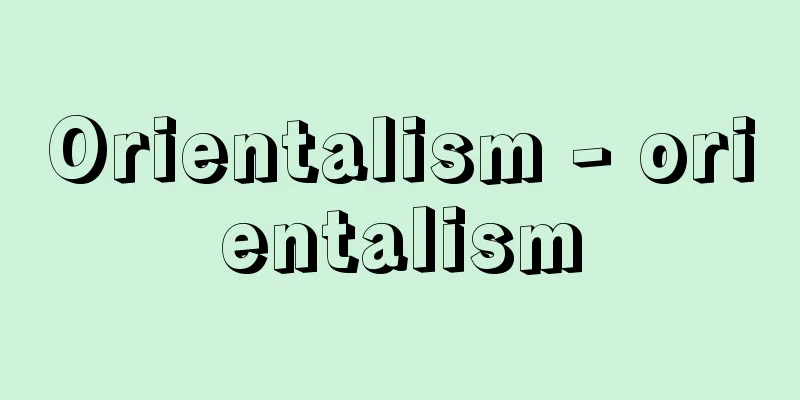Orientalism - orientalism

|
A literary and artistic trend in early modern Europe, referring to a love of the Orient. The concept of "Orient" in this term is not as strict as the Orient in archaeology or history, but includes the Far East and northern Africa, and refers to the entire Eastern world as seen from Europe. With Napoleon's Egyptian expedition and the annexation of Algeria to France, the Orient went beyond being an object of admiration and became a familiar object of interest and concern, and the French and British in particular came into close contact with the Orient, resulting in the production of many works and studies that could be called Orientalism from the 18th to the 19th centuries. [Kenshiro Takami and Hiroshi Kume] Orientalism in Literature and the ArtsIn literature, works such as Montesquieu's "Persian Letters" and Voltaire's "Mohammed" from the 18th century compared Eastern and Western civilizations from the perspective of Enlightenment thought, while in the 19th century, Hugo, Chateaubriand, Lamartine, and Flaubert took the East as their subject and produced works full of exoticism, an element of Romanticism. In the French art world, Jules Robert Auguste (1789-1850) was one of the first painters to use the Orient as a subject, and he was also a collector of Oriental ornaments. However, the painter who actually led Orientalism was Delacroix, who traveled to Morocco and Algeria in 1832 and produced masterpieces such as Women of Algiers. After Delacroix, Alexandre Decamps (1803-60) and Eugène Samuel Auguste Fromentin (1820-76) were among those who preferred Eastern themes. These painters are called Orientalists in the strict sense. Many of them were interested in exoticism, but their contributions to art history, such as the discovery of brilliant colors, should not be overlooked. Interest in the Orient was not limited to these Romantic painters, but was also shared by Neoclassicists such as Ingres, Chardin, Chassériau, and Jean Léon Gérôme (1824-1904). Among these, Ingres's "Grande Odalisque" and "Turkish Bath" are the most famous. If we expand the Orient to include the Far East, chinoiserie and japonisme would also be included in the broader definition of Orientalism. Chinoiserie means Chinese style or Chinese taste. After the Age of Discovery, Chinese cultural artifacts were brought to Europe, and under their influence, Chinese-style furniture, ceramics, textiles, prints, and gardens appeared in Europe from the late 17th century to the late 18th century. Japonism means Japanese style or Japanese taste, and refers to the interest in Japanese art that began in France in the late 19th century with the introduction of Japanese art by the Goncourt brothers. Ukiyo-e in particular was widely collected and loved, and influenced Impressionist paintings. It is also called Japonaiserie. [Kenshiro Takami and Hiroshi Kume] Orientalism as a Dominant Cultural ModeThe term Orientalism has taken on a meaning other than the traditional concept of Eastern interest or Eastern studies due to the influence of Edward Said's book Orientalism, published in 1978. In this book, Said criticized the very concept of the Orient and Orientalism, claiming that they were unilaterally created by Westerners. Since the 18th century, Westerners have had a strong interest in the Eastern world and have engaged in negotiations with the Orient for various purposes, including military, commercial, artistic, and academic, resulting in the production of a vast amount of literature. According to Said, between 1800 and 1950, 60,000 books on the Near East were published in Europe, and a systematic field of Oriental studies was established. Following Michel Foucault, Said regards these as a whole as a discourse. Said closely examines and analyzes the Orient as a discourse, and thoroughly and persistently demonstrates that "Orientalism is a mode of cultural domination of the West over the East, and is therefore nothing other than the product of European ethnocentrism." The Orient here refers mainly to the Islamic Orient in the Near East and North Africa. The Islamic world is close to the Christian world and has always been a geographical and cultural source of anxiety for Europeans. From the 8th century to the 16th century, the Islamic world was politically and culturally superior to the European world. Humanism, which prepared the way for the Renaissance, was also the result of Greek and Roman culture being absorbed by the European world via the Islamic world. Eventually, this situation was reversed, and from the 19th century until World War II, Britain and France dominated the Orient and Orientalism, and after the war, America took over. Orientalism strongly reflects this superiority relationship between Europe and the Orient. Europeans create an image of the Orient in a binary opposition to themselves, as the "other." In other words, compared to Europe, the Orient is always backward, passive, stagnant, irrational, sensual, etc. Europeans then came to believe that it was the West's mission to restore the lost greatness of the classical Orient, and this became one of the justifications for Western colonialism. As a typical example of such discourse, Said cites Antoine-Isaac Silvestre de Sacy (1758-1838), the founder of Orientalism, and his successor Ernest Renan. When Europeans discovered Sanskrit at the end of the 18th century and found that it was older than Hebrew and belonged to the Indo-European language family, the relationship between "Semitic languages" such as Hebrew and Arabic and Indo-European languages was reversed. Renan, a Semitic linguist, declared that Semitic languages were a depraved form of language, both ethically and biologically, compared to Indo-European languages. Renan further generalized Semitic languages, creating a type called "Semitic peoples," which he considered to be an "inferior mix of human nature" in comparison to Aryans. However, Said emphasizes that such concepts as "Semitic languages" and "Semitic peoples" were nothing more than creations in the philological laboratory of Sacy and Renan. Said's book sparked a controversy immediately after its publication, which shows the difficulty of understanding other cultures, not just Orientalism. This is because even if we try to understand a different culture, it ultimately comes down to "representing" it within the framework of our own language and culture. One of the influences of Said's book was the emergence of a movement to discover and appreciate Oriental art for its own sake, without Western prejudice. [Hiroshi Kume] "Returning to Palestine" by E. W. Said, translated by Shimoda Inuhiko (1999, Sakuhinsha)" ▽ "Culture and Imperialism 1" by E. W. Said, translated by Ohashi Yoichi (1988, Misuzu Shobo)" ▽ "What is an Intellectual?" by E. W. Said, translated by Ohashi Yoichi (1988, Heibonsha)" ▽ "The World, the Text, the Critic" by E. W. Said, translated by Yamagata Kazumi (1988, Hosei University Press)" ▽ "Orientalism, Volumes 1 and 2 by E. W. Said, translated by Imazawa Noriko (1993, Heibonsha)" ▽ "The Present of History and Regional Studies: A Perspective on the Modern Middle East" by Itagaki Yuzo (1992, Iwanami Shoten)" ▽ "The Imperialism of Knowledge" by P. A. Cohen, translated by Sato Shinichi Orientalism and the Image of China (1988, Heibonsha)" ▽ Imabuku Ryuta, Creoleism: The Hetherology of Culture (1991, Seidosha) ▽ Inaga Shigemi, Lecture Series on Twentieth-Century Art 1: Nineteenth-Century French Painting and Its Externality: On Orientalism (1989, Iwanami Shoten) ▽ Iyanaga Nobumi, The Prison of History: Into the Space of Things: Orientalism as a Problem (1988, Seidosha) ▽ Nishikawa Nagao, How to Cross Borders: An Introduction to Comparative Cultural Theory (1992, Chikuma Shobo) [References] | | | | | | | | | | | | | |Source: Shogakukan Encyclopedia Nipponica About Encyclopedia Nipponica Information | Legend |
|
近世ヨーロッパにおける文学・芸術上の一風潮で、東方趣味の意。この呼称に含まれる「オリエント」の概念は、考古学や歴史学上のオリエントほど厳密なものではなく、極東やアフリカ北部までも含み、ヨーロッパからみた東方世界全体をさす。ナポレオンのエジプト遠征、アルジェリアのフランスへの併合などによって、オリエントはあこがれの対象を超えて、身近な興味と関心の対象となり、とりわけフランス人とイギリス人はオリエントと深い接触をもつようになり、その結果オリエンタリズムとよばれる作品や研究が18世紀から19世紀にかけて多数生み出された。 [高見堅志郎・久米 博] 文学・芸術上のオリエンタリズム文学では、18世紀のモンテスキューの『ペルシア人の手紙』やボルテールの『マホメット』などは啓蒙(けいもう)思想的観点から東西の文明比較を行い、19世紀にはユゴー、シャトーブリアン、ラマルチーヌ、フロベールらが東方に題材をとり、ロマン主義の一要素である異国趣味(エキゾチシズム)あふれる作品を発表した。 フランス美術界では、ジュール・ロベール・オーギュストJules Robert Auguste(1789―1850)は初めてオリエントを題材にした画家の一人であり、またオリエントの装飾品のコレクターでもあった。しかし事実上オリエンタリズムを導いたのは、1832年にモロッコやアルジェリアを旅行して『アルジェの女たち』などの傑作を残したドラクロワである。ドラクロワののち、ドゥカンAlexandre Decamps(1803―60)、フロマンタンEugène Samuel Auguste Fromentin(1820―76)らが東方主題を好んでとりあげた。これらの画家は狭義のオリエンタリストとよばれる。その多くは異国情緒に興味を示したものであるが、輝かしい色彩の発見など、美術史に貢献した要素も見逃せない。オリエントへの関心はこれらロマン派の画家たちばかりでなく、アングル、シャルダン、シャッセリオ、ジェロームJean Léon Gérôme(1824―1904)ら、新古典主義者たちにも共通してあった。なかでもアングルの『グランド・オダリスク』や『トルコ風呂』が有名である。 オリエントを極東にまで拡大すれば、シノワズリーchinoiserieやジャポニスムjaponismeも広義のオリエンタリズムに含まれよう。シノワズリーは中国風、中国趣味の意味で、大航海時代以降、中国の文物がヨーロッパにもたらされ、それに影響されて17世紀後半から18世紀後半にかけて中国風の家具、陶磁器、織物、版画、庭園がヨーロッパに登場した。ジャポニスムは日本風、日本趣味の意味で、19世紀後半フランスでゴンクール兄弟の紹介で始まった日本美術への趣味をさす。とくに浮世絵は広く収集・愛好されて印象派の絵にも影響を与えた。ジャポネズリーともよばれる。 [高見堅志郎・久米 博] 文化支配様式としてのオリエンタリズムオリエンタリズムという語は、エドワード・サイードが1978年に発表した著書『オリエンタリズム』の影響によって、従来の東方趣味、東方研究という以外の語義を帯びるようになった。彼はこの著書で、そもそもオリエントやオリエンタリズムとは西洋人が一方的につくり上げた概念であるとして、その概念自体を批判した。 18世紀以来西洋人は東方世界に旺盛(おうせい)な興味を抱き、軍事的、商業的、芸術的、学術的とさまざまな目的でオリエントと交渉をもち、その結果膨大な文献が生み出された。サイードによれば、1800年から1950年までにヨーロッパで近東を扱った書物は6万冊に上り、体系的なオリエント学が成立したのである。それらの全体をサイードは、ミシェル・フーコーにならってディスクール(言説)としてとらえる。サイードはこの言説としてのオリエントを綿密に検討し、分析して、「オリエンタリズムは西洋の東洋に対する文化的支配の様式であり、したがってそれはヨーロッパ人の自民族中心主義(エスノセントリズム)の所産にほかならない」ということを、つぶさに、執拗(しつよう)に論証するのである。 ここでいうオリエントとは、主として中近東、北アフリカのイスラム的オリエントをさす。イスラム世界はキリスト教世界に近接し、ヨーロッパ人にとってたえず地理的、文化的に不安をかきたてる存在であった。イスラム世界は8世紀から16世紀までは、ヨーロッパ世界に対し、政治的、文化的に優位に立っていた。ルネサンス(文芸復興)を準備した人文主義(ユマニスム)もイスラム世界を経由してギリシア、ローマ文化がヨーロッパ世界に摂取されたものであった。やがてそれが逆転し、19世紀から第二次世界大戦まではイギリス、フランスがオリエントとオリエンタリズムを支配し、大戦後はアメリカがそれを引き継いだ。オリエンタリズムにはこうしたヨーロッパのオリエントに対する優越関係が色濃く反映している。ヨーロッパ人は自分たちに対する「他者」として、二項対立をなすようにオリエント像をつくり上げる。すなわちヨーロッパと比較してオリエントはつねに、後進的、受動的、停滞的、非合理的、官能的、等々なのである。そしてヨーロッパ人は、失われた過去の古典的なオリエントの偉大さを回復してやるのが西洋の使命であると自負するようになり、それは欧米の植民地主義の根拠の一つとなった。 そうした言説の典型的な例として、サイードはオリエンタリズムの創始者シルベストル・ドゥ・サシAntoine-Isaac Silvestre de Sacy(1758―1838)とその継承者エルネスト・ルナンをあげる。18世紀末にヨーロッパ人はサンスクリット語を発見し、それがヘブライ語よりも古く、インド・ヨーロッパ語族に属することがわかると、ヘブライ語やアラビア語などの「セム語」とインド・ヨーロッパ語との関係は逆転する。セム語学者のルナンは、セム語をインド・ヨーロッパ語と比べて、倫理的にも生物学的にも堕落した形態であると断定する。ルナンはセム語をさらに一般化して、「セム族」という類型をつくりだし、それをアーリアンと比較して「人間性の劣悪な配合」とみなすのである。しかしこうした「セム語」「セム族」といった概念は、サシやルナンによる文献学の実験室での創造物にほかならない、とサイードは強調する。 サイードのこの著書は、発表直後から賛否両論を巻き起こした。それはまたオリエンタリズムに限らず、異文化理解の困難さを示している。異文化を理解しようとしても、それは結局自分の言語や文化の枠組みでそれを「表象」することに帰するからである。サイードのこの著書のもたらした影響の一つは、オリエントの芸術を西洋的偏見なしに、それ自体として発見し、評価しようとする動きが現れたことである。 [久米 博] 『E・W・サイード著、四方田犬彦訳『パレスチナへ帰る』(1999・作品社)』▽『E・W・サイード著、大橋洋一訳『文化と帝国主義1』(1988・みすず書房)』▽『E・W・サイード著、大橋洋一訳『知識人とは何か』(1988・平凡社)』▽『E・W・サイード著、山形和美訳『世界・テキスト・批評家』(1988・法政大学出版局)』▽『E・W・サイード著、今沢紀子訳『オリエンタリズム 上下』(1993・平凡社)』▽『板垣雄三著『歴史の現在と地域学 現代中東への視角』(1992・岩波書店)』▽『P・A・コーエン著、佐藤慎一訳『知の帝国主義 オリエンタリズムと中国像』(1988・平凡社)』▽『今福龍太著『クレオール主義 The Hetherology of Culture』(1991・青土社)』▽『稲賀繁美著『講座二十世紀の芸術1 十九世紀フランス絵画とその外部 オリエンタリズムをめぐって』(1989・岩波書店)』▽『彌永信美著『歴史という牢獄 ものたちの空間へ 「問題としてのオリエンタリズム」』(1988・青土社)』▽『西川長夫著『国境の越え方 比較文化論序説』(1992・筑摩書房)』 [参照項目] | | | | | | | | | | | | | | |出典 小学館 日本大百科全書(ニッポニカ)日本大百科全書(ニッポニカ)について 情報 | 凡例 |
<<: Orienteering - orienteering
Recommend
Wandering woman - yukoujofu
〘 noun 〙 A woman who had no fixed residence and tr...
Spilogale putorius (English name) Spilogaleputorius
...Distributed from the southern United States to...
Wajima Lacquerware
Lacquerware produced in Wajima on the Noto Penins...
Kanezane Kujo
A politician in the early Kamakura period. He was...
Illustrated Sutra of Cause and Effect
This is a pictorial explanation of the "Kako...
Tomariura
Currently Toba City, Mie Prefecture. Located at th...
Esthe-so - Esthe-so
Located in Tivoli, just outside Rome, this is one ...
Self-governance
Generally, it means that a person or group handle...
Akashi Man
This is the common name for the left hipbone of a...
surface creep
…Silt is difficult to move due to the cohesive fo...
Ethnomusicology
…A branch of musicology. Because the subject and ...
Curie, Pierre and Marie
(Husband) Pierre 15 May 1859, Paris - 19 April 190...
Gaultheria
…It is an evergreen shrub of the Ericaceae family...
Aotearoa
...It is a multicultural and multilingual country...
libretto
The brand name of a Windows mini-notebook computer...









